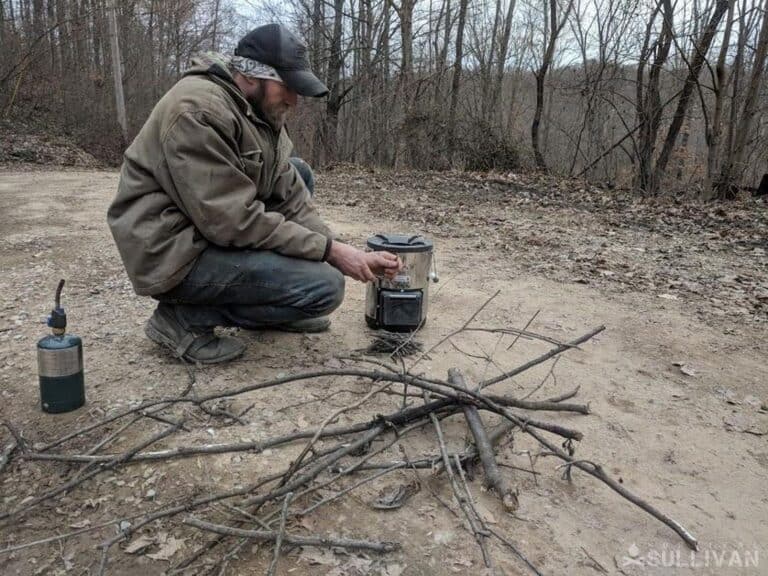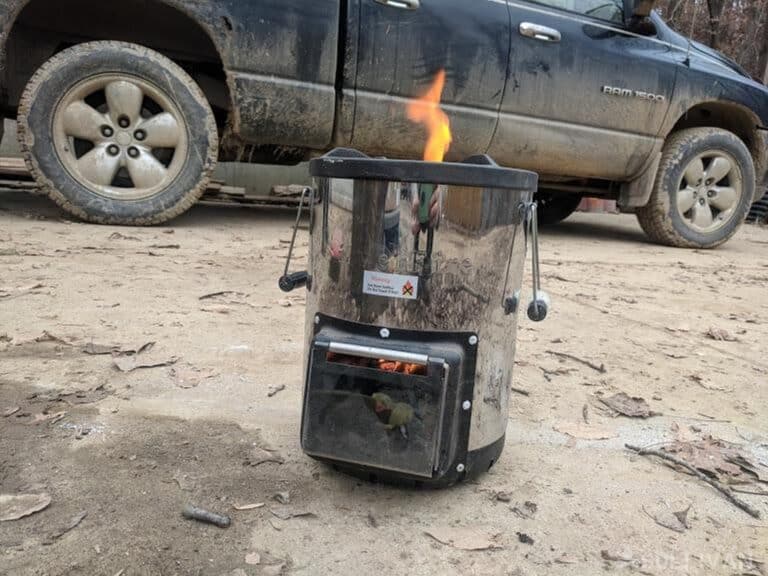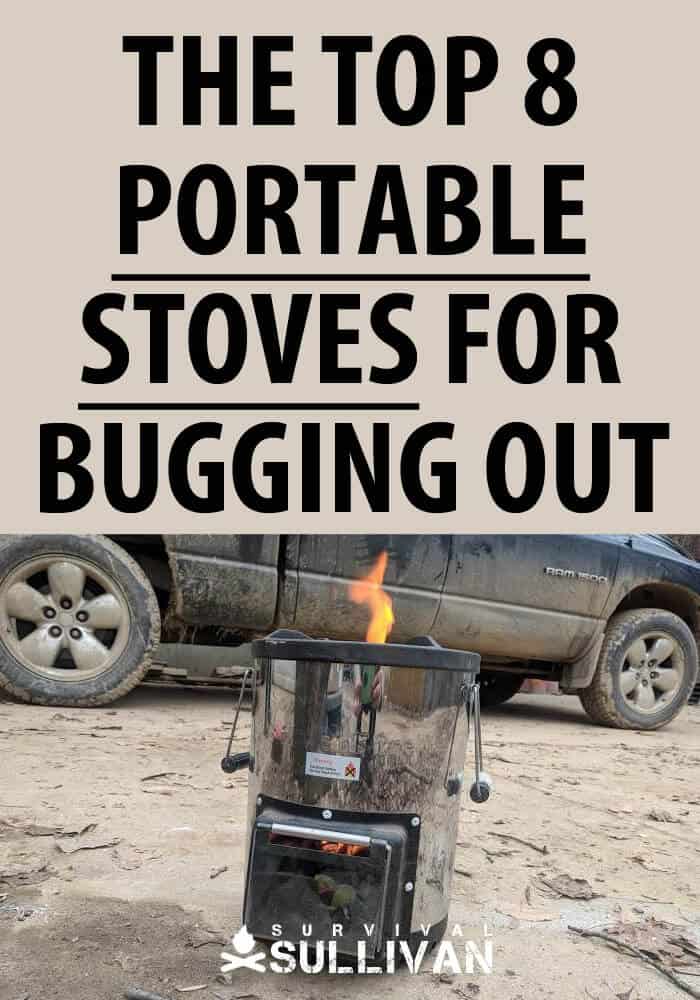During a SHTF situation you must have a heat source that functions on readily available fuel to boil water for purification, cook, stay warm, and perhaps even to cauterize a wound.
Quality survival stoves must be three things: lightweight, portable, and quick lighting. You might think that all lightweight emergency stoves are also portable, but that isn’t necessarily so.

Before browsing for the perfect emergency stove to suit your needs, it is essential to define what a survival stove is and what it is not. A survival stove can be a camping stove – but not every camping stove is best suited for use during a SHTF bugout situation.
While many camping stoves are lightweight and portable, some are better suited for “glamping” and/or making a fuel traditional meal and to be set up for a weekend outing – no be toted along in a bugout bag.
Larger camping stoves do have value as long as you are traveling in a vehicle and have stockpiled plenty of small propane tanks to power it.
Rocket stoves are another top quality off the grid heating and cooking option – but again, not necessarily designed with portability in mind. Because rocket stove comes in a variety of sizes, it is possible to make great use of a rocket stove’s rapid heating capabilities, only on a slightly smaller scale.
During a long-term SHTF disaster, the survival stove you purchased with a bugout scenario in mind could ultimately become your sole source of heat. Building a fire is of course, the best way to warm yourself quickly, but doing so can break sight and smell discipline – or dry fuel could be extremely scarce.
A smaller version of a rocket stove or a homemade hobo stove can accomplish the same goal with significantly less smoke, and no visible flames.
Bug out stoves are only as portable as the instrument being used to carry them. If you are planning on bugging out in a car or a truck, the emergency stove can be a lot larger and heavier than a survival stove that is going to be carried by person on foot, on horseback, or on an all-terrain vehicle.
Even if you’re shopping for a portable emergency stove to pack away in your bugout vehicle, your chances of survival will diminish greatly if you don’t also consider what will happen if your trusty survival stove suddenly becomes unusable.
Table of Contents
Choosing The Right Survival Stove
Now that you have a better idea of what a survival stove is, let’s delve deeper into this type of survival stove on the market and into their composition.
A bugout survival stove should function on as little and as easily found fuel as possible.
Fuel Types
The most popular and durable types of survival stoves each comes with their own unique set of pros and cons pertaining to fuel usage. Most emergency heat sources use alcohol, 1-time use canisters, liquid fuel, wood, and solid fuel – typically low-level brush like leaves and twigs.
Usage
Determine how you are most likely going to use your survival stove and in what type of environment before opening your wallet.
If you are planning to cook food over an open fire (unless OPSEC dictates otherwise), you may want to buy a portable version of a rocket stove simply to boil water quickly, and to use during the evening hours to keep the person on perimeter patrol warm without creating visible flames or intense smoke.
If you plan to be doing the bulk of your cooking on the survival stove during the bugout, consider purchasing a camping stove that allows you to control the heat and provides a larger cooking service that is less resistant to wind, but fuel will be in infinite supply.
Durability
The survival stove will need to be able to take a beating and remain functional when exposed to the elements. A homemade hobo stove, portable rocket stove, and DIY alcohol stoves will be far more likely to remain functional after being exposed to dampness, than a conventional camping stove.
Purchase Price
You could pay a little (next to nothing for a DIY rocket stove or alcohol stove) or around $100 – or more, for commercially produced rocket stoves and camping stoves, or you can attempt to make your own out of basic materials.

Rocket Stoves
The SilverFire is my favorite version of a portable manufactured survival stove. It is fairly lightweight and small – yet not small and lightweight enough to be carried in a bugout bag.
This version of a rocket stove is incredibly durable and can get water to a boiling point rapidly. But the version that is comprised with a stainless steel middle is definitely not ideal in a bugout situation because it’s far too reflective.
One of the best features of the SilverFire rocket stove (and similar models) is that it uses just a small amount of leaves and twigs to function. Unless you are in the desert, there should always be enough fuel laying around for this portable rocket stove, even after a rain – without having to whip out a hatchet to gather kindling.
The Scout Stove and the Mini Dragon survival stoves by the same manufacturer are smaller and far more bugout bag ideal versions of a rocket stove.
Hot Water Rocket
This small stove weighs just around 2 pounds and stands less than 24 inches tall – making it a good bugout bag survival stove from a portability perspective. It’s large enough to boil a single survival food packet, make a little bit of coffee or tea, or boil a small amount water for purification purposes.
It takes about an hour to bring water to a boil on this stove. It uses two parabolic reflectors to harness solar rays and a vacuum tube that is filled with water to help produce heat.
Hobo Stoves
This DIY portable survival stove will not allow you to cook a meal like a camping stove or the Crisis Cooker, but can easily heat up a can of soup on top of this homemade #10 metal can stove.
While this stove is portable and lightweight, it does take up a significant amount of room in a bugout bag. If you are bugging out an ATV, this type of stove could be easily packed.
Log Stoves
You can pack this little stove with you or make it during your bugout from found items. Use a drill (manual or power tool) to cut a hole about six inches deep in the middle of the log.
Drill a second whole that intersects with the initial hole on its underbelly. Use leaves, twigs, or dry stray as fuel.
Butane and Propane Stoves
These stoves and the canisters that power them are self-contained, and basically considered safe to transport in a vehicle because the possibility of leaking in exceedingly low. The quick-burning fuel is also prone to rapid boiling and cooking times.
Disclosure: This post has links to 3rd party websites, so I may get a commission if you buy through those links. Survival Sullivan is a participant in the Amazon Services LLC Associates Program. As an Amazon Associate, I earn from qualifying purchases. See my full disclosure for more.
JetBoil is one of the most popular bugout bag type butane or propane powered stove. It’s lightweight and takes up far less space than a Hobo stove – but it will have a finite fuel supply (that will have to be toted with you) like a conventional camping stove.
WhisperLite is also a quality version of this type of portable emergency stove. This type of survival stove can typically bring water to a boil in about 4 minutes and weigh about 12 ounces – without an attached canister.
The MSR Pocket Rocket 2 is another highly portable butane powered survival stove. This pocket stove weighs a little less than three ounces with the included built-in pot stand included.
The carrying arms on the MSR fold down when it is not being used to help conserve space before being placed in its lightweight plastic case. A knob on the stove allows you to control the little flame to adjust it from a simmer height to a boiling point. You do not have to but a special set of pots or pans for the Pocket Rocket 2, about any camping set or small cast iron cookware will suffice.
Alcohol Stoves
These small yet fairly mighty stoves typically weigh only a single ounce – sometimes less. Many manufactured versions can weigh up to two ounces if you also purchase the add-on wind screen and cross-stand…both of which I highly recommend.
The popular Evernew alcohol stove model weighs a little over five ounces when the add-on titanium cook pot is also added.
Trail Designs Caldera Cone
The Caldera Cone version of an alcohol stove includes a measuring cup and a caddy that can be rolled up, includes a fuel bottle for the alcohol, measuring cup, and plastic caddy to roll up and carry all of the Cone’s components when not in use.
This Trail Designs stove is incredibly popular with both backpackers and preppers because of its quality design and only 2 to 3 ounces of weight.
Camping Stoves
Conventional camping stoves are too large and heavy for a prepper’s backpack, but make an excellent addition to one’s bugout vehicle stash. Their fuel source (propane canisters) is finite, so relying only on a stove like this after store shelves empty is not a viable option from a survival perspective.
But, as long as your propane stockpiles lasts, and you can remain moving in your bugout vehicle, you will be able to cook quickly in nearly any kind of weather without a visible flame.
Wrap Up
Remember the prepping rule of thumb when planning a portable survival stove, “One is none and two is one.” Even though you may need to travel light during the SHTF bugout, possessing more than one type of emergency stove could save your life – especially if bugging out during the winter months.
Although I can’t recommend highly enough investing in survival stoves that require only found items for fuel, buying a conventional camping stove or rocket stove to keep in your bugout vehicle will provide more versatility in what you can cook and how quickly you can purify water.


Tara Dodrill is a homesteading and survival journalist and author. She lives on a small ranch with her family in Appalachia. She has been both a host and frequent guest on preparedness radio shows. In addition to the publication of her first book, ‘Power Grid Down: How to Prepare, Survive, and Thrive after the Lights go Out’, Dodrill also travels to offer prepping tips and hands-on training and survival camps and expos.

I am a fan of the Emberlit style folding box like camp stove. They are very compact (fold completely flat) and sturdy and need little fuel- maybe not as efficient as a rocket stove but more portable and some generic similar small models on Amazon are only about $13. They can burn small sticks, pine cones, leaves etc so fuel is not usually an issue so is very sustainable unlike many mentioned in your article. The sterno camp stove is also quite inexpensive and can burn twigs (or the sterno fuel cans-that I don’t use) and folds flat. I love my box stove and it is the only one I pack unless I am going to hike somewhere above the tree line where there is no fuel – an event unlikely to happen if I was bugging out. What are your thoughts?
Just curious why an Esbit style portable stove didn’t make the grade… Can work with trioxane fuel tabs (which also make great firestarters) or plain wood, enough to hold a metal mug or small pot, plus once the heat source is gone it cools really fast to repack and carry. Small enough to keep on a belt kit, including some fuel tabs and a lighter inside the stove, but enough to get the job done.
Old and ill, not able to bug out. So will stay in HUD housing on ground level. Could the small “rocket stove” function to cook our beans and rice…inside?